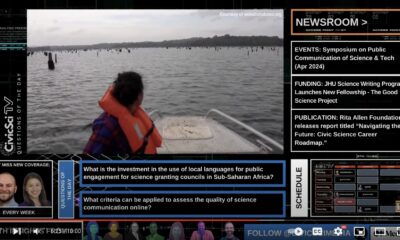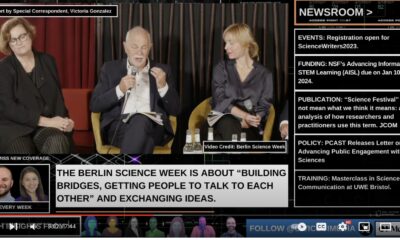CivicSciTV
Talking mental health, public opinion on scientists, artists for science: CivicSciTV News (Jan. 29)
In this episode of CivicSciTV’s Newsroom hosted by Jake Krauss, a range of engaging topics at the intersection of science and society are explored. Krauss delves into innovative SciComm strategies for discussing mental health with teens, particularly emphasizing the role of gamification during the COVID-19 pandemic. He highlights a YouGov survey revealing diverse American perspectives on scientists, shedding light on the public’s trust and expectations of the scientific community. Additionally, Krauss calls attention to an artistic opportunity at the Science in the City festival in Malta, encouraging artists to collaborate in expressing scientific concepts. Watch to learn more!
CivicSciTV
Inside Genspace: Exploring the theory of change behind the world’s 1st community biology lab

CivicSciTV’s Questions of the Day Host Fanuel Muindi sits down to talk with staff members Casey Lardner and Vanessa Champagne from Genspace, the world’s first community biology lab located in the heart of Brooklyn, New York. Fanuel asks a range of questions covering the theory of change, the meaning of impact, partnerships, challenges, members, and so much more. Vanessa and Casey share insights on the evolution of the lab, the impact of their work on local communities, and the challenges and successes of operating a community-based scientific environment. They delve into the various community projects including their Break into Biotech program that they recently launched with support from the New York City Economic Development Corporation.https://www.genspace.org/
Key Insights
1. Community Engagement and Education: One of the foundational aspects of Genspace’s operation is its emphasis on community engagement and education. The lab is not just a place for conducting experiments; it serves as a learning hub for people from diverse backgrounds including artists, tech enthusiasts, and entrepreneurs. This model fosters a unique interdisciplinary approach to science, making it accessible and engaging to a broader audience. This has been successful in demystifying science and making it part of the community’s daily dialogue.
2. Hands-On Science: Genspace offers hands-on experience in various scientific fields such as biohacking, genetic engineering, and biomaterials. This practical approach is crucial in a field where traditional educational institutions often rely heavily on theoretical knowledge. By enabling community members to engage in real-world scientific activities, Genspace not only enhances their understanding but also stimulates innovation and creativity in scientific endeavors.
3. Challenges: Operating a community lab comes with its own set of challenges. Funding remains a significant hurdle, as the operation of such a lab is costly, and finding financial support for adult education and innovative projects is often more challenging than for youth programs. Additionally, balancing the educational needs of a diverse group of participants requires constant adaptation and development of new teaching strategies that minimize jargon and maximize engagement.
4. Impact Measurement and Theory of Change: The impact of Genspace is measured not just by the scientific outcomes but also by the personal growth and development of its members. The lab has seen individuals with no prior scientific background becoming proficient and even changing their career trajectories. This aspect highlights Genspace’s role in shaping science identities where individuals see themselves as capable of contributing to science regardless of their original field of study or profession.
5. Future Aspirations and Expansion: There is a clear vision for the future expansion of Genspace to make its offerings more accessible to a wider audience. The idea of replicating the Genspace model in other boroughs or regions reflects a strategic goal to decentralize and democratize access to scientific education and community collaboration.
Conclusion
The conversation with Genspace representatives underscores a transformative approach to community science education. By lowering barriers to entry, fostering a collaborative environment, and emphasizing hands-on learning, Genspace is not just educating but also empowering citizens to engage with science in meaningful ways. This model serves as a blueprint for future initiatives aiming to integrate science into community settings globally.
Follow Up Questions
- (1) How does Genspace prioritize its resources among various projects and educational programs? What criteria are used to determine the allocation of limited resources?
- (2) How does Genspace assess the educational outcomes of its programs? Are there specific metrics or feedback mechanisms in place to measure the effectiveness of your teaching methods?
- (3) What has been the most surprising feedback from the community regarding their experience at Genspace? Can you share examples of how specific feedback influenced your operational or educational strategies?
- (4) What are the biggest challenges (beyond funding) for community science labs like Genspace in the near future?
CivicSciTV
Navigating the intersection of agency & urgency: Meghan Groome on New York Academy of Science’s civic science portfolio of projects

Questions of the Day (QOTD) Host Fanuel Muindi talks with Meghan Groome, the Senior Vice President for Education at the New York Academy of Sciences (NYAS). She has over 20 years of experience as a science educator and oversees a portfolio of science education programs that aim to engage students and build enthusiasm for science. A core part of NYAS’s theory of change is on using a collective impact model that focuses on activating its vast network of scientist members who participate in various science education initiatives. They employ a service learning model where scientists not only serve as mentors, but they also gain valuable skills in communication, pedagogy, and mentoring. The programs are designed to give teachers and students agency in driving projects based on their interests and needs. Groome discusses strategies for scaling science education initiatives such as building capacity through partnerships with aligned organizations, utilizing technology to reduce administrative burden, and providing training for scientists on public engagement. She emphasizes the importance of discovering student and teacher motivations, ensuring the experience is fun and meaningful. The conversation provides insights into NYAS’s experiential science education programs and their efforts to drive engagement, access, and scale through service learning models and strategic partnerships.
Suggested citation for this conversation: Groome, M., & Muindi., FJ. Navigating the sweet spot between agency and urgency through the New York Academy’s science education and public engagement programs. (Video) Civic Science Television Network. April 28, 2024.
Useful Links NYAS: https://www.nyas.org/ Meghan Groome Bio: https://www.nyas.org/person/meghan-groome-phd/
Additional Readings How do undergraduate STEM mentors reflect upon their mentoring experiences in an outreach program engaging K-8 youth?
https://stemeducationjournal.springeropen.com/articles/10.1186/s40594-017-0057-4 A Theoretical Framework on Reflection in Service Learning: Deepening Reflection Through Identity Development. https://www.frontiersin.org/articles/10.3389/feduc.2020.604997/full More to come!
— What action did the stakeholder insights inspire you to take? Share here: https://shorturl.at/ySVX8
Search for more insights on the Civic Science Media Terminal (CSM Terminal): https://civicsciencemedia.org
CivicSciTV
Why public engagement is, and always has been and always will be, critical for science

Professor Bruce Lewenstein from Cornell University addresses the point “Why public engagement is, and always has been and always will be, critical for science.
Actionable Insights
Professor Lewenstein underscores the indispensable role of public engagement in science, highlighting its historical roots and evolving nature. It’s critical to know where we have been in order to know where we could potentially go. For researchers, practitioners, and community leaders, some of the actionable insights include the importance of embracing multi-directional engagement strategies, acknowledging and reflecting on the ethical and societal implications of their work, and actively engaging with diverse audiences. He stresses the need for the scientific community to foster dialogues that are inclusive and responsive to public concerns, thereby building trust and facilitating a more informed and engaged public. This approach is essential for addressing complex, multifaceted issues (“wicked problems”) that science seeks to solve, urging a shift towards more collaborative and transparent engagement with society at large.
Photo. Credit: Karlsruhe Institut Fur Technologie Sustain.Berlin, Drusnoise | Quantum Inspired Sounds (Forum) (Berlin Science Week 2023).
-
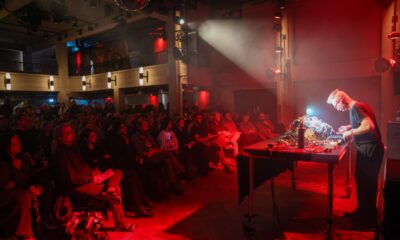
 CivicSciTV2 months ago
CivicSciTV2 months agoWhy public engagement is, and always has been and always will be, critical for science
-

 Civic Science Times3 months ago
Civic Science Times3 months agoOpinion: The growing imperative for civic science journalism
-

 CivicSciTV4 months ago
CivicSciTV4 months agoIn the path of totality, poems on citizen science, & civic science fellowships! CivicSciTV News 1/15
-

 Civic Science Times3 months ago
Civic Science Times3 months agoLiving Proof: An example of when civic science enters the beauty world
-

 CivicSciTV5 months ago
CivicSciTV5 months agoColleen Kelley’s mission is to build molecular literacy through imaginative chemistry comic books
-
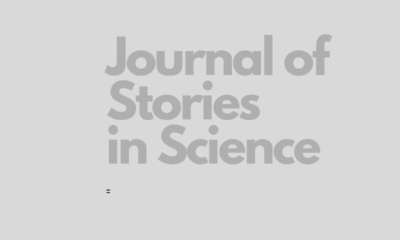
 People3 years ago
People3 years agoMy Career Path Following Water from the Mountain to the Sea and Across an Ocean
-

 Science Policy5 months ago
Science Policy5 months agoEmily Edwards: Public should have a front-row seat to the development of quantum science.
-
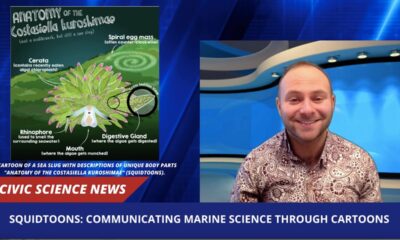
 CivicSciTV2 months ago
CivicSciTV2 months agoMaking science engagement fun, humor, science cartoons & SciTalk 2024! CivicSciTV News (Mar. 4)

